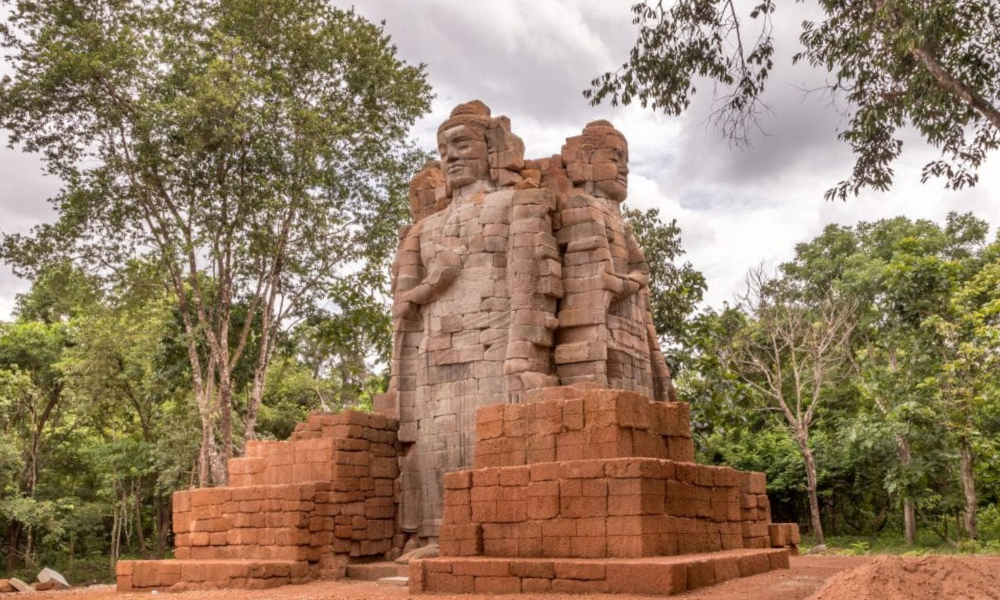Preah Khan Temple (Kompong Svay)

Deep in the jungles of Preah Vihear province, Cambodia, the ancient temple of Preah Khan Kompong Svay highlights the architectural brilliance of the 12th-century Khmer Empire. This largely unexplored site offers a unique adventure for visitors. The temple is open daily from 7:00 AM to 5:00 PM.
Table of Contents
ToggleA brief one-day excursion allows for the exploration of the renowned remote sites, including Preah Vihear Temple, Koh Ker Temple, and Beng Mealea Temple, all...
Layout and Design
Preah Khan Kompong Svay spans approximately 22.5 square kilometers and features four concentric enclosures. Unlike most Khmer sites, which are typically oriented towards the east, this temple complex is aligned to the northeast. It is supplied with water from a large baray measuring 2.8 km by 750 m, which is now nearly dry, located on the eastern side. At the center of the baray, on an artificial island known as mebon, stands Preah Thkol, a cruciform temple constructed of sandstone, distinguished by its central standing tower. In the southeastern corner, one can find the remnants of the 15-meter-high pyramid of Preah Damrei, which is enclosed by laterite and features two stone elephants at its upper corners. The other two elephants are housed in the National Museum of Cambodia and the Guimet Museum in Paris.
Within the outer enclosure, situated in the middle of the western side of the baray, lies Prasat Preah Stung, notable for its unique four-faced central tower in the Bayon style. This structure is preceded by a landing stage adorned with nāga balustrades. A laterite causeway connects this area to a central enclosure measuring 701 m by 1097 m, which is surrounded by a moat and features four gopuras reminiscent of Angkor Thom. Adjacent to the eastern gopura, there is a dharmasala.
The inner laterite enclosure houses the central sanctuary, which is elevated on a two-tier platform. Unfortunately, the central tower collapsed during a looting incident in 2003. This sanctuary has entrances facing all cardinal directions and is encircled by a gallery with windows.
History of Preah Khan Kompong Svay
Emerging from the depths of the Cambodian jungle, Preah Khan Kompong Svay narrates the stories of a distant past. Constructed in the 12th century during the reign of King Jayavarman VII, this splendid temple stands as a testament to the Khmer Empire’s golden age. Enveloped in an aura of mystery, it offers a glimpse into its illustrious history.
At the height of the Khmer Empire, Preah Khan Kompong Svay was not merely a place of worship; it also served as a vital administrative center, overseeing the surrounding territories and regulating an essential eastward trade route. Its expansive area, which is 11 times larger than that of Angkor Wat, underscores its significance.
Although time has taken its toll, the temple’s elaborate carvings provide insights into its historical narrative. Depictions of deities such as Vishnu and Shiva grace the walls, revealing the religious convictions of the empire. Illustrations of everyday life and mythical beings transport visitors to a bygone era, showcasing the vibrant culture of the Khmer civilization.
Despite its magnificence, the prominence of Preah Khan Kompong Svay was relatively fleeting. By the 15th century, the once-thriving city was mysteriously deserted. Various theories propose that internal strife, changes in power, or environmental factors may have contributed to its decline.
Though it lies in ruins, Preah Khan Kompong Svay remains a silent witness to the artistic and political prowess of the Khmer Empire. In contemporary times, archaeologists and adventurous travelers endeavor to uncover its mysteries, piece by piece, ensuring that its legacy continues to evoke admiration and intrigue.
Best Time to Visit Preah Khan Kompong Svay
The optimal period for visiting Preah Khan Kompong Svay is during the dry season, which spans from November to April.
- Dry Season (November – April): This ideal timeframe is characterized by abundant sunshine and pleasant temperatures ranging from 20 to 32 degrees Celsius. The clear skies enhance the visibility of the temple’s intricate carvings, making it an excellent opportunity for photography. However, visitors should anticipate larger crowds during this peak season.
- Shoulder Season (May & October): These months serve as a transitional phase, offering a favorable balance. Temperatures are slightly cooler, and the number of tourists decreases, allowing for a more tranquil exploration of the site. Occasional rain showers contribute to the lush greenery and provide a welcome break from the heat.
- Green Season (June – September): Although heavy rainfall may interfere with travel plans, this season transforms the landscape into a lush paradise. The abundant foliage surrounding the temple creates a captivating atmosphere. Budget-conscious travelers will find lower prices during this off-peak period.
Insider Tip: It is advisable to avoid visiting during Khmer New Year, typically in April, as many businesses close and prices tend to rise. However, for those interested in experiencing the local culture, this period offers a unique opportunity to engage with the customs and traditions of the Khmer people.
Location & How to Get Preah Khan Kompong Svay
Preah Khan Kompong Svay is situated approximately 180 kilometers from Siem Reap and does not have an airport, necessitating the use of land transportation for access:
From Siem Reap:
– Private taxi or car: This option offers the most convenience and flexibility, with a travel time of 2 to 3 hours (cost: $50-100+).
– Shared taxi: A more economical choice, though it may involve a longer journey and additional stops (cost: $20-30 per person).
– Bus: The least expensive alternative, but it is also the slowest and operates on a limited schedule (cost: $5-10 per person).
From Phnom Penh:
– Private taxi or car: This mode of transport is pricier compared to the journey from Siem Reap, taking approximately 5 to 6 hours (cost: $100-200+).
– Bus: This option entails a lengthy and exhausting trip, lasting between 8 to 10 hours (cost: $10-20 per person).

